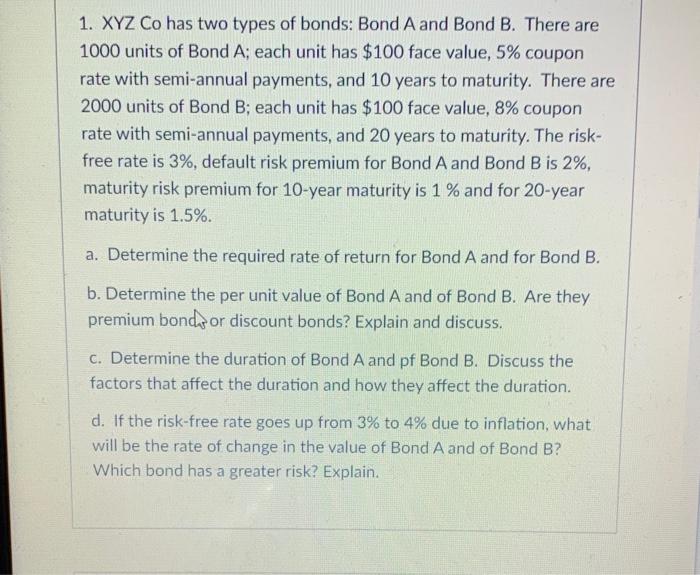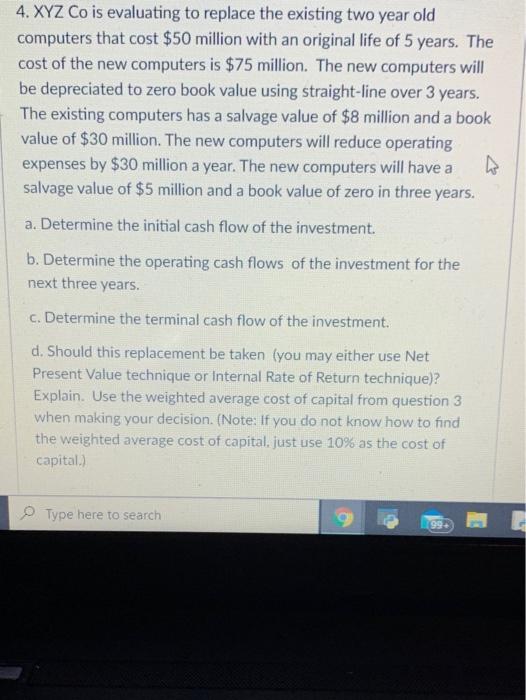3. XYZ Co has two mutually exclusive investments X and Y. Investment X has an initial capital outlay of $105 million, and the investment is expected to generate $64 million in one year, $45 million in two years and $30 million in three years. Investment Y has an initial capital outlay of $125 million, and the investment is expected to generate $ 70 million in one year. $55 million in two years and $40 million in three years. a. Use the information from Question 1 and Question 2, determine the market value of debt (both Bond A and Bond B), market value of equity, and the capital structure of XYZ Co (% of debt capital and % of equity capital). b. Use the information from Question 1 and Question 2, determine XYZ's after tax cost of debt (for both Bond A and Bond B), cost of equity and weighted average cost of capital, assuming XYZ's tax rate is 20%. c. Determine the internal rate of return of Investment X. Investment Y and Marginal Investment (Y-X). Which investment should be chosen? Explain. (Note: If you do not know how to find the weighted average cost of capital, just use 10% as the cost of capital.) d. Determine the net present value of Investment X. Investment Y and Marginal Investment (Y-X). Which investment should be chosen? Explain. (Note: If you do not know how to find the weighted average cost of capital, just use 10% as the cost of capital.) Type here to search 99. 1. XYZ Co has two types of bonds: Bond A and Bond B. There are 1000 units of Bond A; each unit has $100 face value, 5% coupon rate with semi-annual payments, and 10 years to maturity. There are 2000 units of Bond B; each unit has $100 face value, 8% coupon rate with semi-annual payments, and 20 years to maturity. The risk- free rate is 3%, default risk premium for Bond A and Bond B is 2%, maturity risk premium for 10-year maturity is 1 % and for 20-year maturity is 1.5%. a. Determine the required rate of return for Bond A and for Bond B. b. Determine the per unit value of Bond A and of Bond B. Are they premium bondror discount bonds? Explain and discuss. c. Determine the duration of Bond A and pf Bond B. Discuss the factors that affect the duration and how they affect the duration d. If the risk-free rate goes up from 3% to 4% due to inflation, what will be the rate of change in the value of Bond A and of Bond B? Which bond has a greater risk? Explain. 2. XYZ Co has 15,000 shares of common stocks. The stock has the price of $60, $63, $60, $67, $70, $69, $81, $78, $81, $88 and $105 from 2010 to 2020, while a stock market index has the value of 100, 105, 102, 110, 125, 120, 135, 130, 145, 155 and 170 from 2010 to 2020. The stock is expected to pay dividend of $3 in one year, $3 in two years, $3 in three years. Its expected price in three years is $65. The risk-free rate is 3%. The stock market index has an expected return of 12%. a. Enter the stock prices and the stock market index into your Excel file column wise. (Two columns and 11 rows), Derive the annual returns of the stock and the stock market index. b. Use Excel Regression under Data Analysis to run a linear regression using stock return as y variable and stock market index as x variable to estimate the beta of the stock. (Alternatively you may find standard deviation of stock and of stock index, and the correlation coefficient of stock return and stock index return to estimate the beta of the stock.) Does the stock have a greater risk than the stock market index? Explain. c. Use the security market line to determine the required rate of return of the stock. d. Determine the per share value of the stock 4.XYZ Co is evaluating to replace the existing two year old computers that cost $50 million with an original life of 5 years. The cost of the new computers is $75 million. The new computers will be depreciated to zero book value using straight-line over 3 years. The existing computers has a salvage value of $8 million and a book value of $30 million. The new computers will reduce operating expenses by $30 million a year. The new computers will have a salvage value of $5 million and a book value of zero in three years. a. Determine the initial cash flow of the investment. b. Determine the operating cash flows of the investment for the next three years. c. Determine the terminal cash flow of the investment. d. Should this replacement be taken (you may either use Net Present Value technique or Internal Rate of Return technique)? Explain. Use the weighted average cost of capital from question 3 when making your decision. (Note: If you do not know how to find the weighted average cost of capital, just use 10% as the cost of capital.) Type here to search 99 3. XYZ Co has two mutually exclusive investments X and Y. Investment X has an initial capital outlay of $105 million, and the investment is expected to generate $64 million in one year, $45 million in two years and $30 million in three years. Investment Y has an initial capital outlay of $125 million, and the investment is expected to generate $ 70 million in one year. $55 million in two years and $40 million in three years. a. Use the information from Question 1 and Question 2, determine the market value of debt (both Bond A and Bond B), market value of equity, and the capital structure of XYZ Co (% of debt capital and % of equity capital). b. Use the information from Question 1 and Question 2, determine XYZ's after tax cost of debt (for both Bond A and Bond B), cost of equity and weighted average cost of capital, assuming XYZ's tax rate is 20%. c. Determine the internal rate of return of Investment X. Investment Y and Marginal Investment (Y-X). Which investment should be chosen? Explain. (Note: If you do not know how to find the weighted average cost of capital, just use 10% as the cost of capital.) d. Determine the net present value of Investment X. Investment Y and Marginal Investment (Y-X). Which investment should be chosen? Explain. (Note: If you do not know how to find the weighted average cost of capital, just use 10% as the cost of capital.) Type here to search 99. 1. XYZ Co has two types of bonds: Bond A and Bond B. There are 1000 units of Bond A; each unit has $100 face value, 5% coupon rate with semi-annual payments, and 10 years to maturity. There are 2000 units of Bond B; each unit has $100 face value, 8% coupon rate with semi-annual payments, and 20 years to maturity. The risk- free rate is 3%, default risk premium for Bond A and Bond B is 2%, maturity risk premium for 10-year maturity is 1 % and for 20-year maturity is 1.5%. a. Determine the required rate of return for Bond A and for Bond B. b. Determine the per unit value of Bond A and of Bond B. Are they premium bondror discount bonds? Explain and discuss. c. Determine the duration of Bond A and pf Bond B. Discuss the factors that affect the duration and how they affect the duration d. If the risk-free rate goes up from 3% to 4% due to inflation, what will be the rate of change in the value of Bond A and of Bond B? Which bond has a greater risk? Explain. 2. XYZ Co has 15,000 shares of common stocks. The stock has the price of $60, $63, $60, $67, $70, $69, $81, $78, $81, $88 and $105 from 2010 to 2020, while a stock market index has the value of 100, 105, 102, 110, 125, 120, 135, 130, 145, 155 and 170 from 2010 to 2020. The stock is expected to pay dividend of $3 in one year, $3 in two years, $3 in three years. Its expected price in three years is $65. The risk-free rate is 3%. The stock market index has an expected return of 12%. a. Enter the stock prices and the stock market index into your Excel file column wise. (Two columns and 11 rows), Derive the annual returns of the stock and the stock market index. b. Use Excel Regression under Data Analysis to run a linear regression using stock return as y variable and stock market index as x variable to estimate the beta of the stock. (Alternatively you may find standard deviation of stock and of stock index, and the correlation coefficient of stock return and stock index return to estimate the beta of the stock.) Does the stock have a greater risk than the stock market index? Explain. c. Use the security market line to determine the required rate of return of the stock. d. Determine the per share value of the stock 4.XYZ Co is evaluating to replace the existing two year old computers that cost $50 million with an original life of 5 years. The cost of the new computers is $75 million. The new computers will be depreciated to zero book value using straight-line over 3 years. The existing computers has a salvage value of $8 million and a book value of $30 million. The new computers will reduce operating expenses by $30 million a year. The new computers will have a salvage value of $5 million and a book value of zero in three years. a. Determine the initial cash flow of the investment. b. Determine the operating cash flows of the investment for the next three years. c. Determine the terminal cash flow of the investment. d. Should this replacement be taken (you may either use Net Present Value technique or Internal Rate of Return technique)? Explain. Use the weighted average cost of capital from question 3 when making your decision. (Note: If you do not know how to find the weighted average cost of capital, just use 10% as the cost of capital.) Type here to search 99










